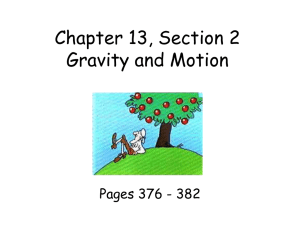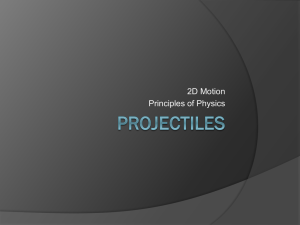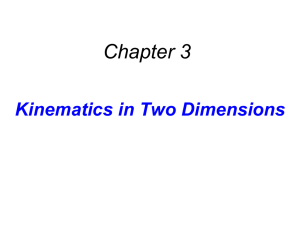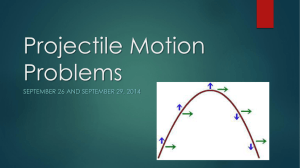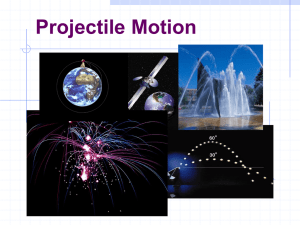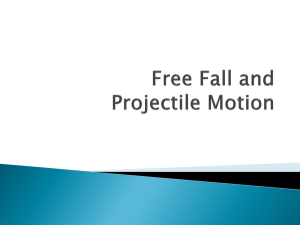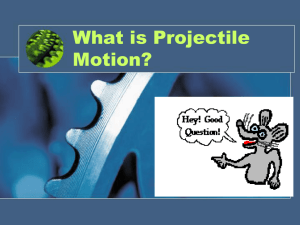Projectile1
advertisement
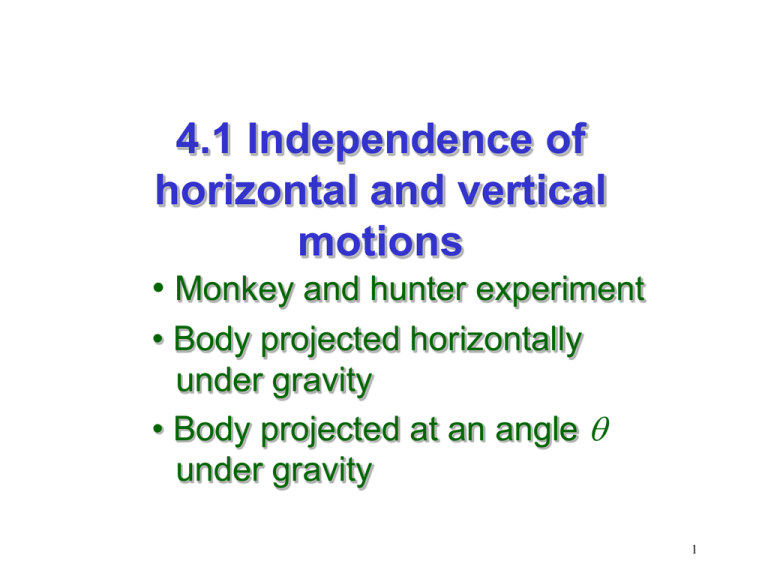
4.1 Independence of horizontal and vertical motions • Monkey and hunter experiment • Body projected horizontally under gravity • Body projected at an angle q under gravity 1 4.1 Independence of horizontal and vertical motions (SB p. 144) What is “projectile motion”? Kicking a football The football will be projected along ____________ path 2 4.1 Independence of horizontal and vertical motions (SB p. 144) Independence of horizontal and vertical motions Assume air resistance is negligible. During the flight, (1)the horizontal velocity ______________ _______________ (2) the vertical velocity is subjected to a _________________________ 3 4 4.1 Independence of horizontal and vertical motions (SB p. 145) Monkey and hunter experiment 2 breaks the aluminium strip and the circuit of the electromagnet 3 1 bullet leaves the mouth of the toy gun iron monkey falls vertically downwards 4 the bullet always hits the monkey 5 4.1 Independence of horizontal and vertical motions (SB p. 145) Monkey and hunter experiment Why does the bullet always hit the monkey? The bullet and the monkey start with _______ vertical downward velocity They fall under the same acceleration due to gravity their vertical motions are __________ Their _______ positions are the same at any instant of time 6 4.1 Independence of horizontal and vertical motions (SB p. 145) Monkey and hunter experiment We can conclude that: The horizontal and vertical components of a projectile motion are ____________ of each other. 7 4.1 Independence of horizontal and vertical motions (SB p. 146) Body projected horizontally under gravity a marble is projected horizontally off the edge of a table travels with a uniform velocity in the horizontal direction and accelerates uniformly downwards due to gravity the horizontal velocity remains constant 8 4.1 Independence of horizontal and vertical motions (SB p. 146) Body projected horizontally under gravity horizontal motion vertical motion They are independent of each other 9 10 4.1 Independence of horizontal and vertical motions (SB p. 152) Body projected at an angle q under gravity Initial vertical velocity: uy = u sinq the object is projected with a velocity u at an angle q to the horizontal Initial horizontal velocity: ux = _________ 11 4.1 Independence of horizontal and vertical motions (SB p. 152) Body projected at an angle q under gravity • The vertical motion of the object undergoes constant acceleration a = –g • Vertical component of velocity (vy) and the vertical displacement (y) at time t : vy y 12 4.1 Independence of horizontal and vertical motions (SB p. 152) Body projected at an angle q under gravity • The horizontal motion is uniform and the object moves with constant velocity • Horizontal velocity component (vx) and the horizontal displacement (x) at time t: vx x 13 4.1 Independence of horizontal and vertical motions (SB p. 152) Body projected at an angle q under gravity • Instantaneous velocity (v): v • The direction of motion at certain instant: tanφ 14 4.1 Independence of horizontal and vertical motions (SB p. 153) Body projected at an angle q under gravity At B, the object reaches its maximum height H with vy = ___, v y 2 uy 2 2as H 15 4.1 Independence of horizontal and vertical motions (SB p. 153) Body projected at an angle q under gravity At D, the time of flight of the object (T) θ T 2usin g 16 4.1 Independence of horizontal and vertical motions (SB p. 153) Body projected at an angle q under gravity Horizontal displacement OD of the projectile is the range R R R 2 u sin2θ g 17 4.1 Independence of horizontal and vertical motions (SB p. 153) Body projected at an angle q under gravity By combining: x and y y x tan θ - g 2 2 2u cos θ x2 where 0o < q < 90o The equation is of the parabolic form y = ax – bx2 trajectory of the projectile is a __________ 18 4.1 Independence of horizontal and vertical motions (SB p. 154) Body projected at an angle q under gravity Note: 1.The vertical and horizontal motions of a projectile motion are independent of each other 2. The trajectory of the projectile is ___________ 3. The maximum value of R is _______ occurs when sin2q = _______ q = ____ maximum range is obtained if the object is projected at an angle ____ to the horizontal 19 4.1 Independence of horizontal and vertical motions (SB p. 154) Body projected at an angle q under gravity Note: 4. sin2q = sin(180o – 2q) two angles of projection for a given range R with a specific speed, except for q = 45o Maximum range at q = 45o Range at 60o = Range at 30o 20 A projectile is launched with an initial velocity of 30 m s-1 at an angle of 60o above the horizontal. Calculate the magnitude and direction of its velocity 5 s after launch. (Take g = 9.8 m s-2) Ans : 27.5 m s-1, 56.9o below the horizontal 21 A police officer is chasing you across a roof top, both are running at 4.5 m s-1. Before you reaches the edge of the roof, you has to decide whether or not to try jumping to the roof of the next building, which is 6.2 m away but 4.8 m lower. Can you make it? 22 Effect of Atmosphere In an projectile experiment, the launch angle is 60 and the launch speed is 100 mi/h and the following results are obtained : Path I (Vacuum) Path II (Air) Range 581 ft 323 ft Maximum height 252 ft 174 ft Time of flight 7.9 s 6.6 s Effects of Air Resistance : (i) (ii) (iii) (iv) The trajectory becomes asymmetric. 23 4.1 Independence of horizontal and vertical motions (SB p. 154) Body projected at an angle q under gravity Note: 5. In real situation, air resistance reduces the speed and the range of the projectile Go to Go to More to Know 1 Example 3 24 End 25 4.1 Independence of horizontal and vertical motions (SB p. 148) Q: An aeroplane, flying in a straight line at a constant height of 500 m with a speed of 200 m s–1, drops an object. The object takes a time t to reach the ground and travels a horizontal distance d in doing so. Taking g as 10 m s–2 and ignoring air resistance, what are the values of t and d ? Solution 26 4.1 Independence of horizontal and vertical motions (SB p. 148) Solution: When the object is released from the aeroplane, Horizontal component of velocity = Velocity of the aeroplane = 200 m s–1 For the vertical motion of the object: Initial velocity = 0, acceleration = g = 10 m s–2, displacement = 500 m 1 Using s ut at 2 500 = 0 + t2 = 100 t = 10 s 1 2 2 10 t2 Return to For the horizontal motion: Distance (d) = 200 t = 200 10 = 2 000 m Text 27 4.1 Independence of horizontal and vertical motions (SB p. 149) Q: When a rifle is fired horizontally at a target P on a screen at a range of 25 m, the bullet strikes the screen at a point 5.0 mm below P. The screen is now moved to a distance of 50 m from the rifle and the rifle again is fired horizontally at P in its new position. Assuming that air resistance may be neglected, what is the new distance below P at which the screen would now be struck? Solution 28 4.1 Independence of horizontal and vertical motions (SB p. 149) Solution: Let v = velocity of the bullet when it leaves the rifle. Time taken for the bullet to travel through a horizontal distance of 25 m (t1) = 25 v Consider vertical motion of the bullet, initial velocity (u) = 0, acceleration (a) = g, displacement (s) = 5.0 10–3 m, time (t1) = Using 25 v 1 2 s ut at 2 2 1 25 3 50 10 0 g 1 2 v 29 4.1 Independence of horizontal and vertical motions (SB p. 149) Solution (cont’d): With the screen at 50 m from the rifle, time of travel (t2) = 50 v Using 1 s ut at 2 2 2 1 50 New distance below P (h) = 0 g 2 2 v (2) (1) 2 50 4 -3 25 5.0 10 h h 20.0 10 20 mm -3 Return to Text 30 4.1 Independence of horizontal and vertical motions (SB p. 154) So far, air resistance has been neglected for projectile motions. In real situations, the trajectory of the projectile is influenced by air resistance in the extent that depends on the mass, shape and size of the objects. Return to Text 31 4.1 Independence of horizontal and vertical motions (SB p. 154) Q: An aeroplane flies at a height h with a constant horizontal velocity u so as to fly over a cannon. When the aeroplane is directly over the cannon, a shell was fired to hit the aeroplane. Neglecting air resistance, what is the minimum speed of the shell in order to hit the aeroplane? (g = acceleration due to gravity) Solution 32 4.1 Independence of horizontal and vertical motions (SB p. 154) Solution: Let v = minimum speed of shell, q = angle of projection. The minimum speed is when the shell will hit the aeroplane at the maximum height of the shell trajectory. Since the shell is fired when the aeroplane is directly above it, the horizontal component of velocity of the shell must be the same as the velocity of the aeroplane, i.e. same u. 33 4.1 Independence of horizontal and vertical motions (SB p. 154) Solution (cont’d): Maximum height Using the equation, h 2 2 v sin θ 2g 2 2 v sin θ 2g 2 2 v sin θ 2 gh (1) Horizontal component of velocity of the shell, v cos θ u v2cos 2θ u2(2) (1) (2) v2sin 2θ v2cos 2θ u2 2gh v u2 2gh Return to Text 34 4.2 Terminal velocity (Vertical motion under gravity with air resistance) 35 4.2 Terminal velocity (Vertical motion under gravity with air resistance (SB p. 157) A parachutist falling in the air falling under influence of air resistance net force acting on him is due to his weight (mg) and the upward air resistance (f) By applying Newton’s Second Law: ma = mg – f 36 4.2 Terminal velocity (Vertical motion under gravity with air resistance (SB p. 157) A parachutist falling in the air his velocity (v) increases the air resistance acting on him becomes larger f = bv where b = constant 37 4.2 Terminal velocity (Vertical motion under gravity with air resistance (SB p. 157) A parachutist falling in the air • moves faster and faster the air resistance = his weight net force acting on him = 0 reaches the terminal velocity (vTA) with 0 acceleration 38 4.2 Terminal velocity (Vertical motion under gravity with air resistance (SB p. 157) A parachutist falling in the air reaches terminal velocity (vTA) with 0 acceleration 0 = mg - bvTA mg v b T A 39 4.2 Terminal velocity (Vertical motion under gravity with air resistance (SB p. 157) A parachutist falling in the air air resistance > parachutist’s weight resultant upward net force acting on him slows him down air resistance 40 4.2 Terminal velocity (Vertical motion under gravity with air resistance (SB p. 157) A parachutist falling in the air the air resistance will be balanced by the weight again at a new lower terminal velocity vTC before he lands safely 41 4.2 Terminal velocity (Vertical motion under gravity with air resistance (SB p. 158) A parachutist falling in the air 42 4.2 Terminal velocity (Vertical motion under gravity with air resistance (SB p. 159) 4.1 Independence of horizontal and vertical motions 1. Assume air resistance is negligible, in a projectile motion, the horizontal velocity remains constant, and the vertical velocity is subjected to a constant acceleration due to gravity. 2. The horizontal velocity (vx) and vertical velocity (vy) are independent of each other in projectile motions. 43 4.2 Terminal velocity (Vertical motion under gravity with air resistance (SB p. 159) 4.1 Independence of horizontal and vertical motions 3. For objects projected horizontally under gravity: (a) The instantaneous velocity (v) of the projectile is: v v x 2 v y 2 44 4.2 Terminal velocity (Vertical motion under gravity with air resistance (SB p. 159) 4.1 Independence of horizontal and vertical motions (b) The direction of motion is determined by: (c) If the projectile is projected at a height H above the ground, its time of flight (tf) is: tanφ v v y x 2H t g f 45 4.2 Terminal velocity (Vertical motion under gravity with air resistance (SB p. 159) 4.1 Independence of horizontal and vertical motions (d) The total horizontal displacement travelled by the object is called the range (R): (e) The trajectory of the projectile is a parabola: 2H R u x g where ux is the initial horizontal velocity g 2 y - x 2u 2 x 46 4.2 Terminal velocity (Vertical motion under gravity with air resistance (SB p. 159) 4.1 Independence of horizontal and vertical motions 4. For objects projected with initial velocity (u) at an angle q under gravity: (a) Its maximum height (H) is: u 2 sin2θ H 2g 47 4.2 Terminal velocity (Vertical motion under gravity with air resistance (SB p. 159) 4.1 (b) Independence of horizontal and vertical motions Its time of flight (tf) is: t f 2u sinθ g q R u2 sin2 g (c) Its range (R) is: (d) The trajectory of the projectile is a 2 g x y x tan θ 2 parabola: 2 2u cos θ 48 4.2 Terminal velocity (Vertical motion under gravity with air resistance (SB p. 159) 4.2 Terminal velocity 5. Consider a parachutist of mass m falling under the influence of air resistance. As the parachutist falls, its velocity (v) increases. When the velocity increases, the air resistance acted on the parachutist also increases. We have: f = bv where f is the air resistance and b is a constant. 49 4.2 Terminal velocity (Vertical motion under gravity with air resistance (SB p. 159) 4.2 Terminal velocity 6. The terminal velocity of the parachutist (vT) is: mg v b T where g is the acceleration due to gravity. 50 4.2 Terminal velocity (Vertical motion under gravity with air resistance (SB p. 160) 51 End 52
